Impact of Different Diagnostic Procedures on Diagnosis, Therapy, and Outcome in Horses with Headshaking: Recommendations for Fast-Track Advanced Diagnostic and Therapeutic Protocols
Abstract
Simple Summary
Abstract
1. Introduction
2. Materials and Methods
2.1. Horses
2.2. Diagnostic Investigation
2.3. Outcome
2.4. Data Analysis
3. Results
3.1. Horses
3.2. Diagnostic Investigation
3.3. Outcome
4. Discussion
5. Conclusions
Supplementary Materials
Author Contributions
Funding
Institutional Review Board Statement
Informed Consent Statement
Data Availability Statement
Acknowledgments
Conflicts of Interest
References
- Newton, S.A.; Knottenbelt, D.C.; Eldridge, P.R. Headshaking in Horses: Possible Aetiopathogenesis Suggested by the Results of Diagnostic Tests and Several Treatment Regimes Used in 20 Cases. Equine Vet. J. 2000, 32, 208–216. [Google Scholar] [CrossRef] [PubMed]
- Madigan, J.; Bell, S. Owner Survey of Headshaking in Horses. J. Am. Vet. Med. Assoc. 2001, 219, 334–337. [Google Scholar] [CrossRef] [PubMed]
- Roberts, V. Managing Headshaking in Horses: An Update. Practice 2018, 40, 157–161. [Google Scholar] [CrossRef]
- Mills, D.; Cook, S.; Taylor, K.; Jones, B. Analysis of the Variations in Clinical Signs Shown by 254 Cases of Equine Headshaking D. Vet. Rec. 2002, 150, 236–240. [Google Scholar] [CrossRef] [PubMed]
- Aleman, M.; Williams, D.C.; Brosnan, R.J.; Nieto, J.E.; Pickles, K.; Berger, J.; Lecouteur, R.A.; Holliday, T.A.; Madigan, J. Sensory Nerve Conduction and Somatosensory Evoked Potentials of the Trigeminal Nerve in Horses with Idiopathic Headshaking. J. Vet. Intern. Med. 2013, 27, 1571–1580. [Google Scholar] [CrossRef]
- Aleman, M.; Rhodes, D.; Williams, D.C.; Guedes, A.; Madigan, J. Sensory Evoked Potentials of the Trigeminal Nerve for the Diagnosis of Idiopathic Headshaking in a Horse. J. Vet. Intern. Med. 2014, 28, 250–253. [Google Scholar] [CrossRef]
- Pickles, K.; Aleman, M.; Cert, M.V.Z.; Marlin, D.J.; Adams, V.J.; Madigan, J. Owner-Reported Response to Treatment of 130 Headshaking Horses. Am. Assoc. Equine Pract. 2014, 60, 176–183. [Google Scholar]
- Voigt, A.; Saulez, M.N.; Donnellan, C.M. Nuchal Crest Avulsion Fracture in 2 Horses: A Cause of Headshaking. J. S. Afr. Vet. Assoc. 2009, 80, 111–113. [Google Scholar] [CrossRef]
- Wimmer-Scherr, C.M.; Evrard, L.; Amory, H.; Cesarini, C. Ulcerative Lesion of the External Ear Canal Causing Headshaking in a Horse. Vet. Rec. Case Rep. 2019, 7, 1–4. [Google Scholar] [CrossRef]
- Pickles, K.; Madigan, J.; Aleman, M. Idiopathic Headshaking: Is It Still Idiopathic? Vet. J. 2014, 201, 21–30. [Google Scholar] [CrossRef]
- Fiske-Jackson, A.R.; Pollock, P.J.; Witte, T.H.; Woolford, L.; Perkins, J.D. Fungal Sinusitis Resulting in Suspected Trigeminal Neuropathy as a Cause of Headshaking in Five Horses. Equine Vet. Educ. 2012, 24, 126–133. [Google Scholar] [CrossRef]
- Kold, S.E.; Østblom, L.C.; Philipsen, H.P. Headshaking Caused by a Maxillary Osteoma in a Horse. Equine Vet. J. 1982, 14, 167–169. [Google Scholar] [CrossRef] [PubMed]
- Mair, T.S. Headshaking Associated with Trombicula Autumnalis Larval Infestation in Two Horses. Equine Vet. J. 1994, 26, 244–245. [Google Scholar] [CrossRef]
- McGorum, B.C.; Dixon, P.M. Vasomotor Rhinitis with Headshaking in a Pony. Equine Vet. J. 1990, 22, 220–222. [Google Scholar] [CrossRef]
- Moore, L.A.; Johnson, P.J.; Messer, N.T.; Kline, K.L.; Crump, L.M.; Knibb, J.R. Management of Headshaking in Three Horses by Treatment for Protozoal Myeloencephalitis. Vet. Rec. 1997, 141, 264–267. [Google Scholar] [CrossRef] [PubMed]
- Schlichenmaier, H. Headshaking Verursacht Durch Ein Osteom in Der Nasenhöhle Eines Pferdes. Pferdeheilkunde 2006, 22, 449–452. [Google Scholar]
- Stephenson, R. An Unusual Case of Headshaking Caused by a Premaxillary Bone Cyst. Equine Vet. Educ. 2005, 17, 79–82. [Google Scholar] [CrossRef]
- Lane, G.; Mair, T.S. Observations on Headshaking in the Horse. Equine Vet. J. 1987, 19, 331–336. [Google Scholar] [CrossRef]
- Roberts, V. Trigeminal-Mediated Headshaking in Horses: Prevalence, Impact, and Management Strategies. Vet. Med. Res. Rep. 2019, 10, 1–8. [Google Scholar] [CrossRef]
- Mair, T.S.; Lane, G. Headshaking in Horses. Practice 1990, 12, 183–186. [Google Scholar] [CrossRef]
- Kloock, T.; Niebuhr, T.; Feige, K. Trigeminus-Mediiertes Headshaking—Von Der Diagnostik Bis Zur Therapie. Pferdespiegel 2021, 24, 52–57. [Google Scholar] [CrossRef]
- Mills, D.; Cook, S.; Jones, B. Reported Response to Treatment among 245 Cases of Equine Headshaking. Vet. Rec. 2002, 150, 311–313. [Google Scholar] [CrossRef]
- Roberts, V. Head Shaking in Horses: Causes, Pain Management and Treatment. Vet Times 2012. Available online: https://www.vettimes.co.uk/app/uploads/wp-post-to-pdf-enhanced-cache/1/head-shaking-in-horses-causes-pain-management-and-treatment.pdf (accessed on 1 September 2022).
- Stange, L.M.; Krieter, J.; Czycholl, I. Overview of the Current Situation in a Sample of Headshakers and Owner Assessment of Effective Therapeutic Measures Used in Germany. J. Equine Vet. Sci. 2020, 95, 103270. [Google Scholar] [CrossRef] [PubMed]
- Kruskal, W.H.; Wallis, A. Use of Ranks in One-Criterion Variance Analysis. J. Am. Stat. Assoc. 1952, 47, 583–621. [Google Scholar] [CrossRef]
- Mann, H.B.; Whitney, D.R. On a Test of Whether One of Two Random Variables Is Stochastically Larger than the Other. Ann. Math. Stat. 1947, 18, 50–60. [Google Scholar] [CrossRef]
- Pearson, K.X. On the Criterion That a given System of Deviations from the Probable in the Case of a Correlated System of Variables Is Such That It Can Be Reasonably Supposed to Have Arisen from Random Sampling. Lond. Edinb. Dublin Philos. Mag. J. Sci. 1900, 50, 157–175. [Google Scholar] [CrossRef]
- Slater, J. Findings from the National Equine Health Survey 2013. Vet. Rec. 2014, 11, 271–272. [Google Scholar] [CrossRef]
- Liuti, T.; Smith, S.; Dixon, P.M. Radiographic, Computed Tomographic, Gross Pathological and Histological Findings with Suspected Apical Infection in 32 Equine Maxillary Cheek Teeth (2012–2015). Equine Vet. J. 2018, 50, 41–47. [Google Scholar] [CrossRef]
- Kinns, J.; Pease, A. Computed Tomography in the Evaluation of the Equine Head. Equine Vet. Educ. 2009, 21, 291–294. [Google Scholar] [CrossRef]
- Fairburn, A.; Meehan, L.; Roberts, V. Computed tomographic findings in 101 horses presented for the investigation of headshaking. Equine Vet. Educ. 2022. [Google Scholar] [CrossRef]
- Thomson, K.; Chan, C.; Dyson, S. Head Tossing Behaviour in Six Horses: Trigeminal-Mediated Head-Shaking or Musculoskeletal Pain? Equine Vet. Educ. 2020, 32, 58–64. [Google Scholar] [CrossRef]
- Roberts, V.; Perkins, J.D.; Skärlina, E.; Gorvy, D.A.; Tremaine, W.H.; Williams, A.; Mckane, S.A. Caudal Anaesthesia of the Infraorbital Nerve for Diagnosis of Idiopathic Headshaking and Caudal Compression of the Infraorbital Nerve for Its Treatment, in 58 Horses. Equine Vet. J. 2012, 45, 107–110. [Google Scholar] [CrossRef] [PubMed]
- Wilmink, S.; Warren-Smith, C.M.R.; Roberts, V. Validation of the Accuracy of Needle Placement as Used in Diagnostic Local Analgesia of the Maxillary Nerve for Investigation of Trigeminally Mediated Headshaking in Horses. Vet. Rec. 2015, 176, 148. [Google Scholar] [CrossRef]
- Kloock, T.; Roberts, V.; Pickles, K.; Uhlendorf, F.; Twele, L.; Wilkens, H.; Stehle, E.; Niebuhr, T.; Feige, K. History Rest and Exercise Score (HRE-S) for Assessment of Disease Severity in Horses with Trigeminal-Mediated Headshaking. Equine Vet. J. 2022; submitted. [Google Scholar]
- Talbot, W.A.; Pinchbeck, G.L.; Knottenbelt, D.C.; Graham, H.; McKane, S.A. A Randomised, Blinded, Crossover Study to Assess the Efficacy of a Feed Supplement in Alleviating the Clinical Signs of Headshaking in 32 Horses. Equine Vet. J. 2013, 45, 293–297. [Google Scholar] [CrossRef]
- Ross, S.E.; Murray, J.K.; Roberts, V. Prevalence of Headshaking within the Equine Population in the UK. Equine Vet. J. 2018, 50, 73–78. [Google Scholar] [CrossRef]
- Madigan, J.; Bell, S. Evaluation and Treatment of Headshaking Syndrome. Am. Assoc. Equine Pract. 1997, 43, 340–342. [Google Scholar]
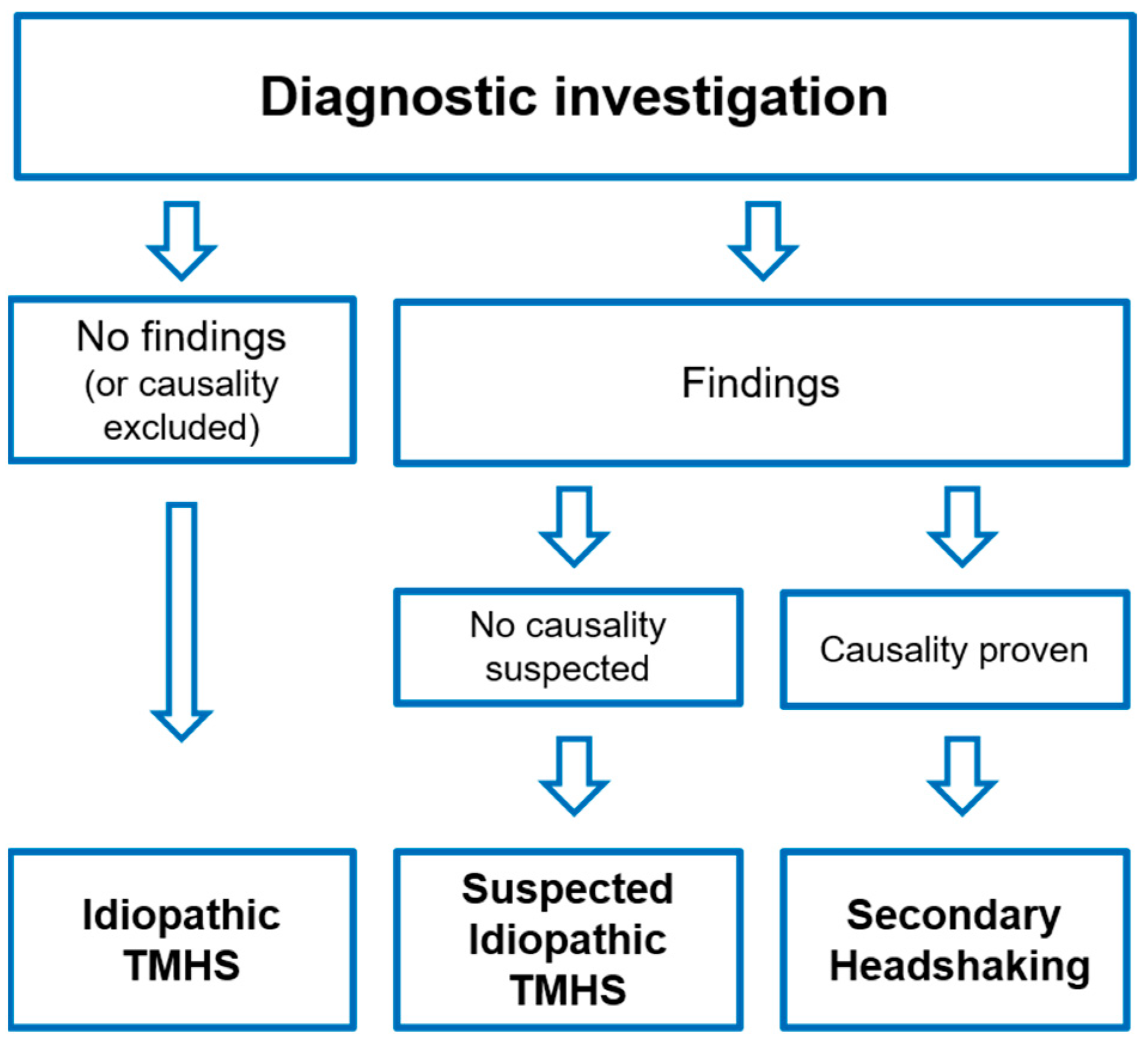
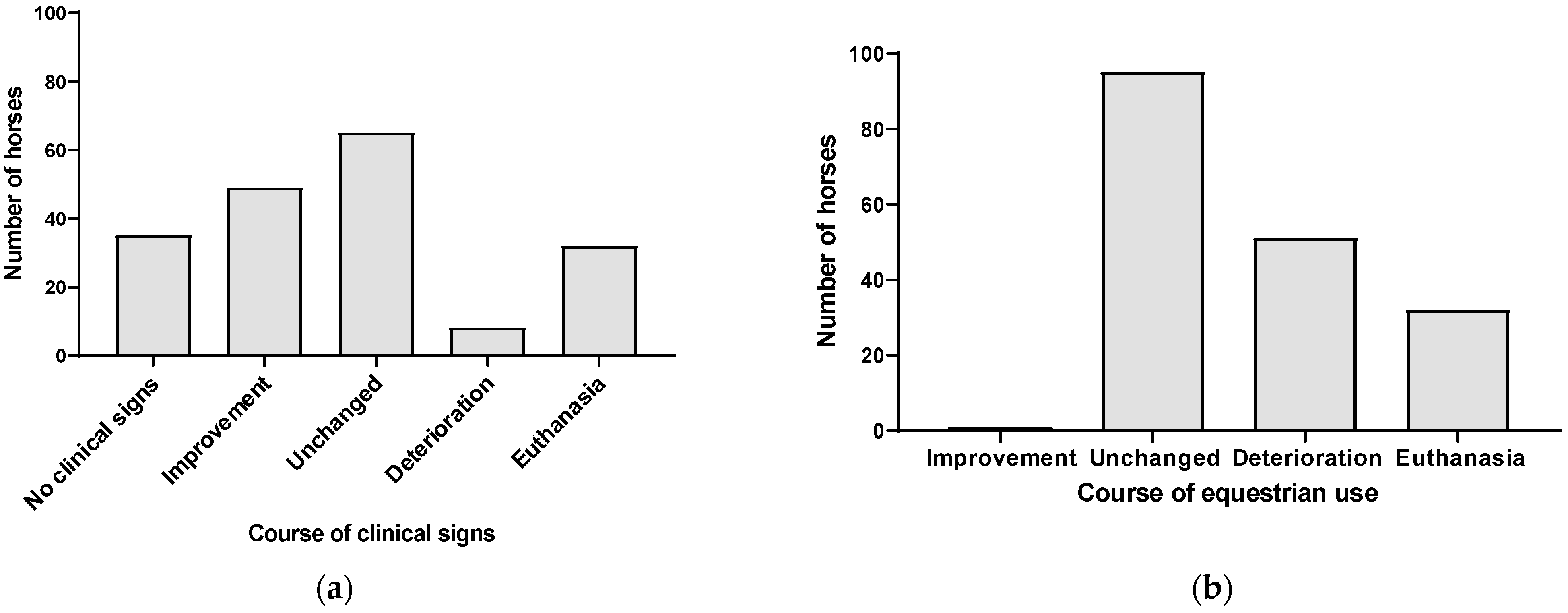
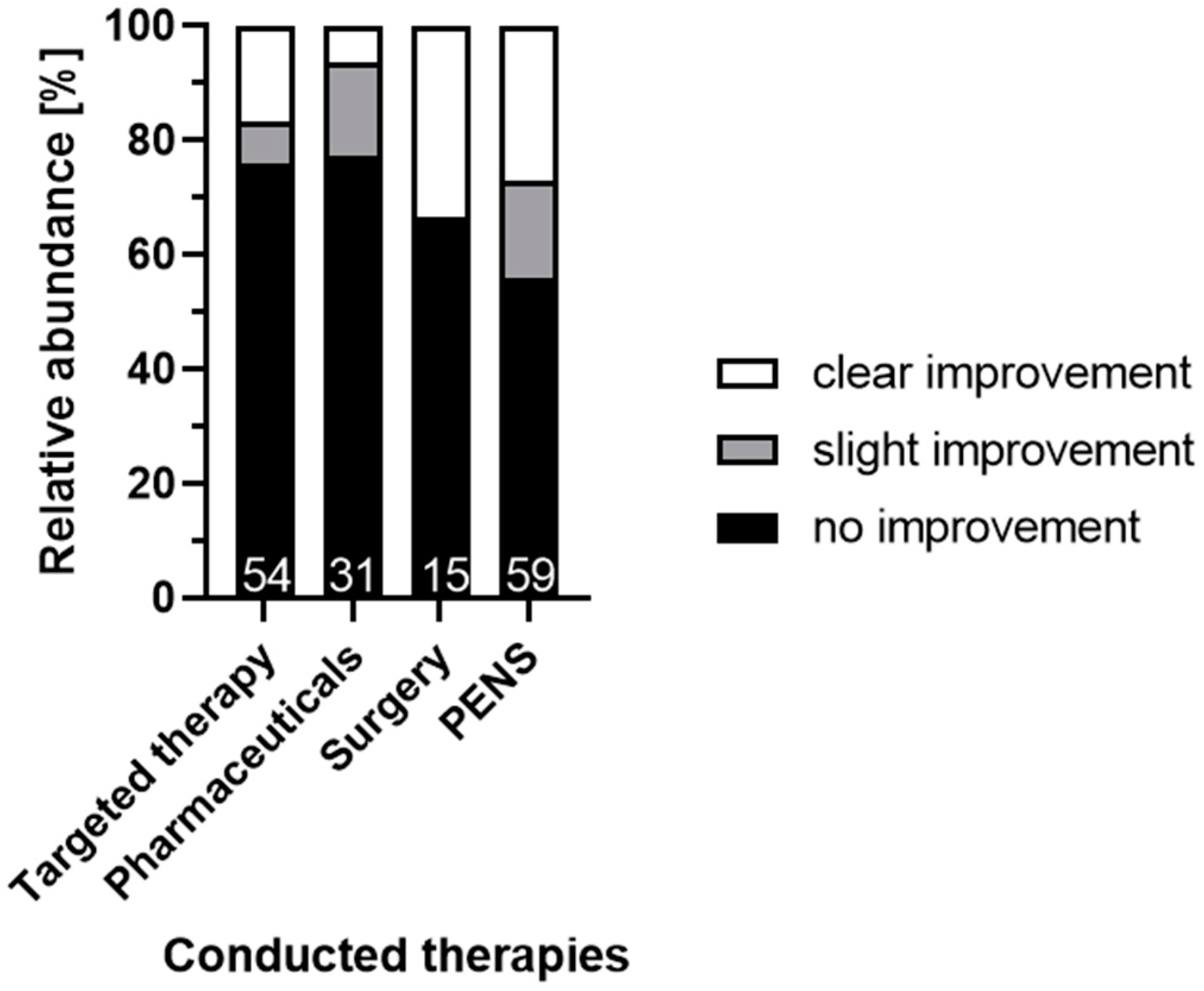
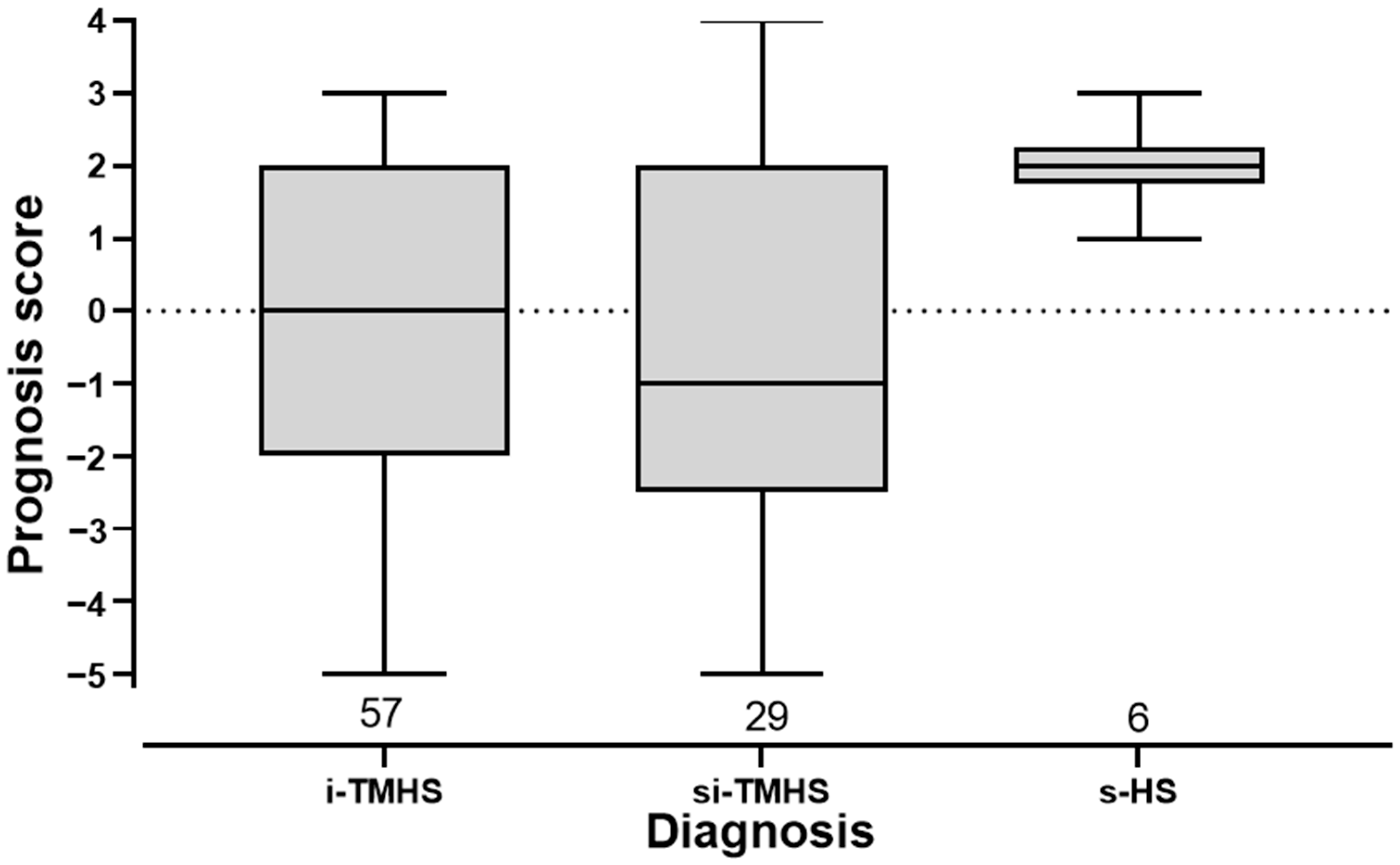

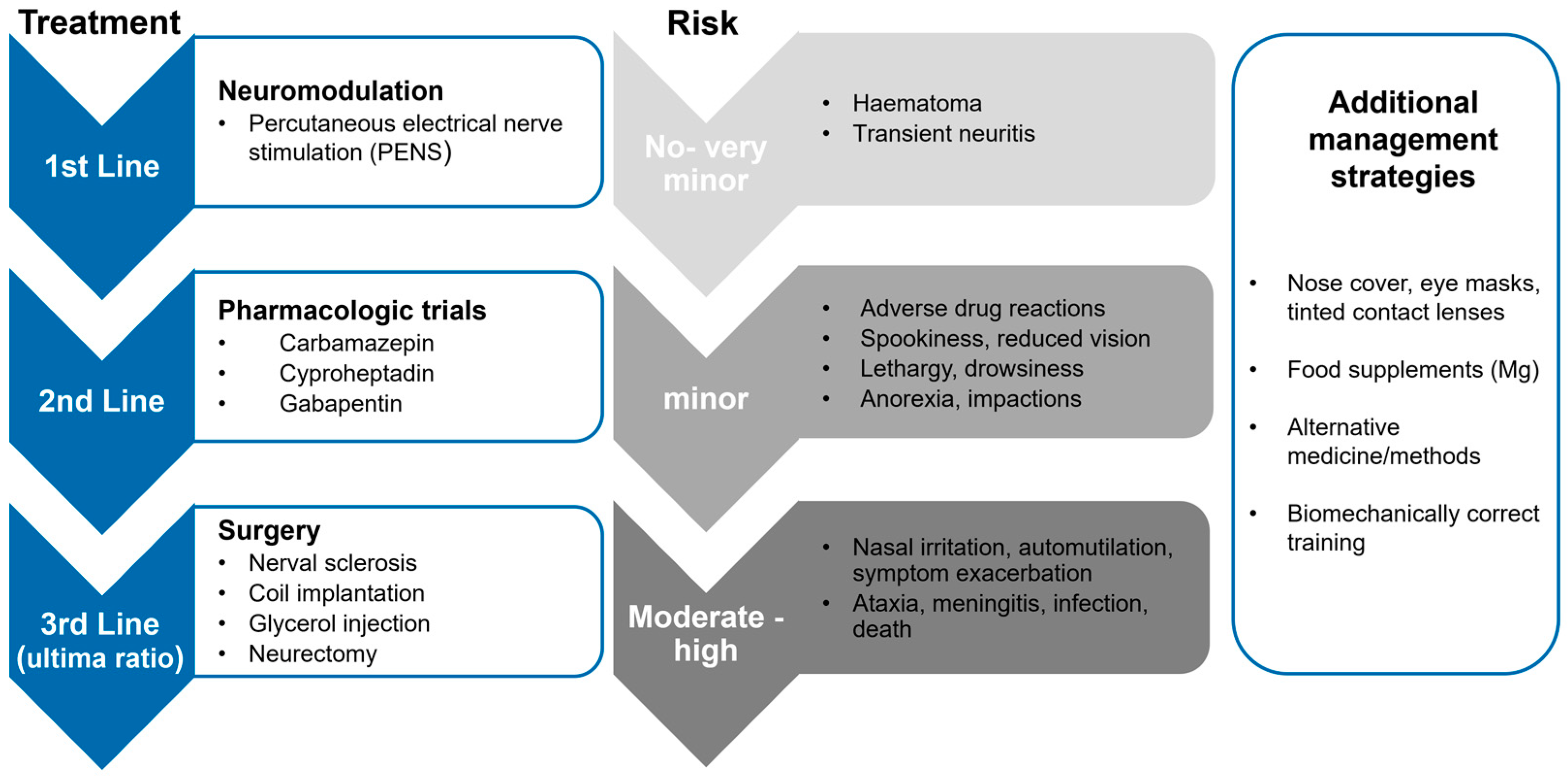
| Diagnostic Procedure | Total (n) | Without Findings | Mild Findings | Moderate Findings | Severe Findings | Not Evaluable; Not Conducted (n; n) |
|---|---|---|---|---|---|---|
| MRI brain and adjacent structures | 112 | 86% (96) | 6% (7) | 8% (9) | 1; 113 | |
| Otoscopy | 133 | 84% (112) | 12% (16) | 4% (5) | 0; 93 | |
| General clinical examination | 225 | 78% (176) | 18% (41) | 4% (8) | 0; 1 | |
| Lower airway endoscopy | 182 | 76% (138) | 24% (44) | 0; 44 | ||
| Radiographs cervical spine | 151 | 74% (111) | 18% (27) | 9% (13) | 1; 74 | |
| Clinical neurological examination | 163 | 70% (114) | 15% (24) | 15% (25) | 1; 62 | |
| Ophthalmological examination | 168 | 67% (112) | 19% (32) | 13% (21) | 2% (3) | 0; 58 |
| CT cervical spine | 33 | 61% (20) | 27% (9) | 12% (4) | 1; 192 | |
| Radiographs head | 194 | 54% (105) | 28% (54) | 18% (34) | 0.5% (1) | 1; 31 |
| Radiographs thoracolumbar spine | 56 | 54% (30) | 32% (18) | 13% (7) | 2% (1) | 1; 169 |
| Clinical examination of thoracolumbar spine | 80 | 39% (31) | 43% (34) | 16% (13) | 3% (2) | 0; 146 |
| Orthopaedic examination | 63 | 37% (23) | 35% (22) | 27% (17) | 2% (1) | 0; 163 |
| CT head | 155 | 17% (27) | 47% (73) | 35% (55) | 1; 70 | |
| Oral examination | 184 | 6% (10) | 42% (78) | 47% (87) | 5% (9) | 3; 39 |
| Upper airway endoscopy | 178 | 6% (10) | 62% (111) | 30% (54) | 2% (3) | 0; 48 |
| Total | 2077 | 54% (1115) | 28% (590) | 17% (352) | 1% (20) |
| Anatomic Region of Finding | Radiographs and CT Negative | Radiographs and CT Positive | Radiographs Positive and CT Negative | Radiographs Negative and CT Positive | Total |
|---|---|---|---|---|---|
| Paranasal sinuses | 82.39% (117) | 4.23% (6) | 0.70% (1) | 12.68% (18) | 142 |
| Canalis infraorbitalis | 68.31% (97) | 0.70% (1) | 0.00% (0) | 30.99% (44) | 142 |
| Teeth | 76.22% (109) | 8.39% (12) | 1.40% (2) | 13.99% (20) | 143 |
| Temporomandibular joint | 79.41% (54) | 0.00% (0) | 0.00% (0) | 20.59% (14) | 68 |
| Cranial attachment of Ligamentum nuchae | 50% (55) | 46.36% (51) | 0% (0) | 3.63% (4) | 110 |
| Ears | 96.08% (49) | 0.00% (0) | 0.00% (0) | 3.92% (2) | 51 |
| Cervical vertebrae | 54.84% (17) | 32.26% (10) | 3.23% (1) | 9.68% (3) | 31 |
| Total | 72.48% (498) | 11.64% (80) | 0.582% (4) | 15.28% (105) | 687 |
| Diagnostic Anaesthesia/Result | Negative | Partly Positive | Positive |
|---|---|---|---|
| Nervus maxillaris (bilateral) | 36/57 (63%) | 13/57 (23%) | 8/57 (14%) |
| Specific findings | 30/43 (70%) | 5/43 (12%) | 8/43 (19%) |
| 8/12 | 2/12 | 2/12 |
| 11/12 | 1/12 | |
| 3/5 | 2/5 | |
| 2/2 | ||
| 2/2 | ||
| 2/2 | ||
| 1/2 | 1/2 | |
| 1/1 | ||
| 1/1 | ||
| 1/1 | ||
| 1/1 | ||
| 1/1 | ||
| 1/1 | ||
| Total | 66/100 (66%) | 18/100 (18%) | 16/100 (16%) |
| Therapy/Response | No Improvement | Slight Improvement | Notable Improvement |
|---|---|---|---|
| Teeth | 24/28 | 4/28 | |
| 10/13 | 3/13 | |
| 1/1 | ||
| 6/6 | ||
| 1/1 | ||
| 3/3 | ||
| 4/4 | ||
| Musculoskeletal/orthopaedic diseases | 7/10 | 1/10 | 2/10 |
| 1/3 | 1/3 | 1/3 |
| 2/3 | 1/3 | |
| 2/2 | ||
| 1/1 | ||
| 1/1 | ||
| Paranasal sinuses | 3/4 | 1/4 | |
| 1/2 | 1/2 | |
| 2/2 | ||
| Ear | 2/5 | 1/5 | 2/5 |
| 1/2 | 1/2 | |
| 1/3 | 1/3 | 1/3 |
| Temporomandibular joint: corticosteroid injection | 2/3 | 1/3 | |
| Eye | 4/5 | 1/5 | |
| 1/2 | 1/2 | |
| 2/2 | ||
| 1/1 | ||
| Systemic therapy due to different diseases (including prednisolone, nonsteroidal anti- inflammatory drugs, antibiotics) | 2/5 | 2/5 | 1/5 |
| Total | 44/60 | 5/60 | 11/60 |
| Underlying Disease | Revealing Diagnostic Procedure |
|---|---|
| Insertional desmopathy of the cranial attachment of the nuchal ligament | CT, radiographs, ultrasonography |
| Fracture of one Processus paracondylaris | CT, ultrasonography |
| Paranasal sinus cyst | CT, radiographs |
| Compression of the infraorbital canal through cheek teeth roots | CT |
| Sinusitis conchae mediae | CT |
| Otitis media sinister | CT, MRI |
| Muscular dysbalance in the pelvic region | Osteopathic examination |
| Fractured tooth root triadan 211 | CT, radiographs |
| Partial crown fracture with pulpitis and alveolitis triadan 209 | CT, oral examination |
| Partial crown fracture triadan 110 in combination with cyst-like lesions in the temporomandibular joint | CT, oral examination |
Publisher’s Note: MDPI stays neutral with regard to jurisdictional claims in published maps and institutional affiliations. |
© 2022 by the authors. Licensee MDPI, Basel, Switzerland. This article is an open access article distributed under the terms and conditions of the Creative Commons Attribution (CC BY) license (https://creativecommons.org/licenses/by/4.0/).
Share and Cite
Kloock, T.; Hellige, M.; Kloock, A.; Feige, K.; Niebuhr, T. Impact of Different Diagnostic Procedures on Diagnosis, Therapy, and Outcome in Horses with Headshaking: Recommendations for Fast-Track Advanced Diagnostic and Therapeutic Protocols. Animals 2022, 12, 3125. https://doi.org/10.3390/ani12223125
Kloock T, Hellige M, Kloock A, Feige K, Niebuhr T. Impact of Different Diagnostic Procedures on Diagnosis, Therapy, and Outcome in Horses with Headshaking: Recommendations for Fast-Track Advanced Diagnostic and Therapeutic Protocols. Animals. 2022; 12(22):3125. https://doi.org/10.3390/ani12223125
Chicago/Turabian StyleKloock, Tanja, Maren Hellige, Anke Kloock, Karsten Feige, and Tobias Niebuhr. 2022. "Impact of Different Diagnostic Procedures on Diagnosis, Therapy, and Outcome in Horses with Headshaking: Recommendations for Fast-Track Advanced Diagnostic and Therapeutic Protocols" Animals 12, no. 22: 3125. https://doi.org/10.3390/ani12223125
APA StyleKloock, T., Hellige, M., Kloock, A., Feige, K., & Niebuhr, T. (2022). Impact of Different Diagnostic Procedures on Diagnosis, Therapy, and Outcome in Horses with Headshaking: Recommendations for Fast-Track Advanced Diagnostic and Therapeutic Protocols. Animals, 12(22), 3125. https://doi.org/10.3390/ani12223125





